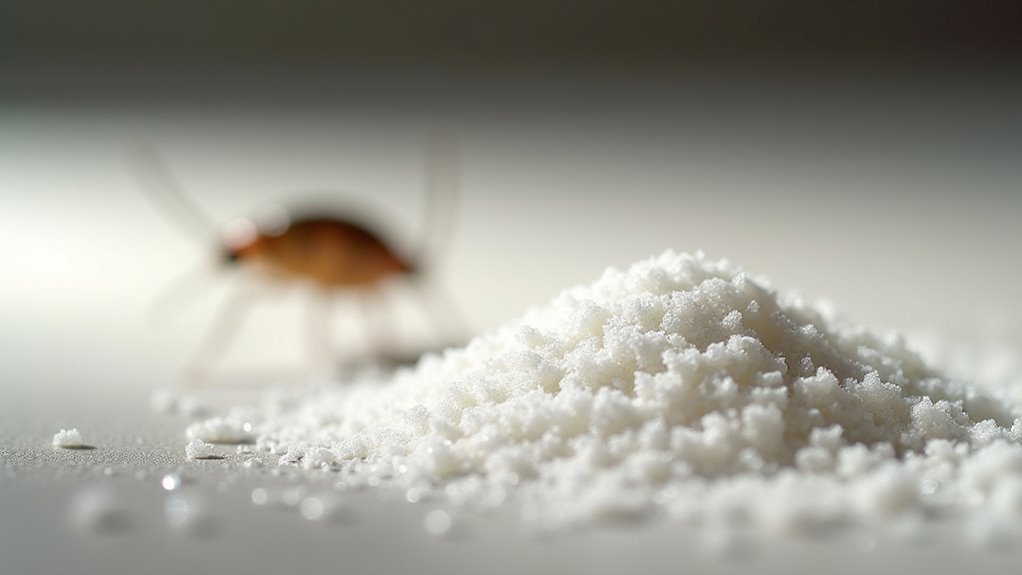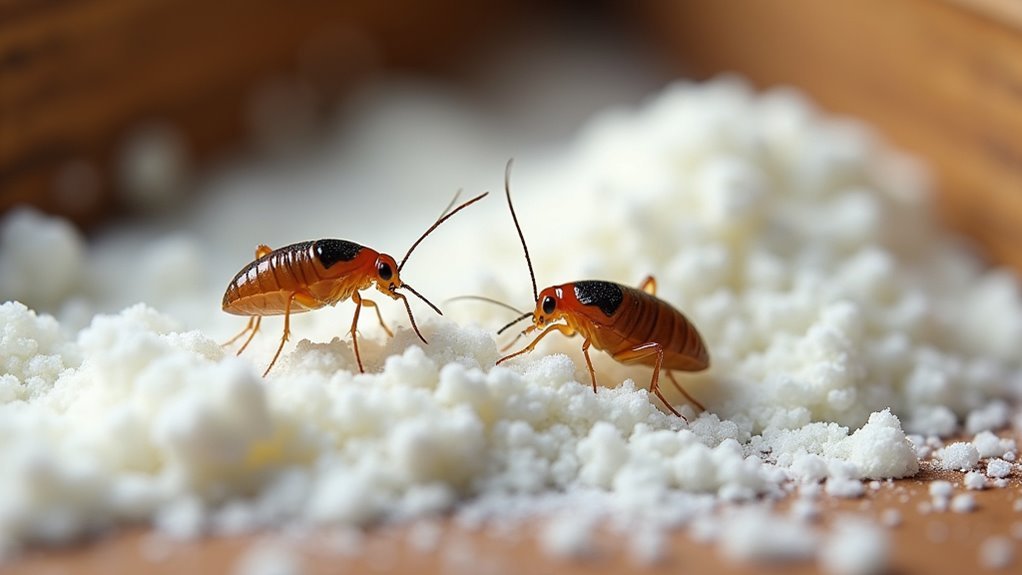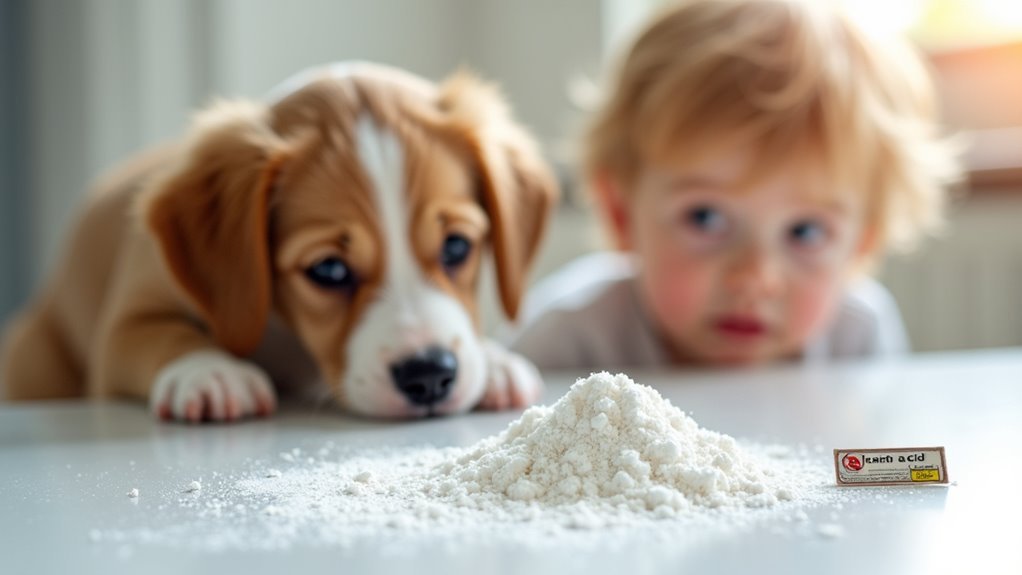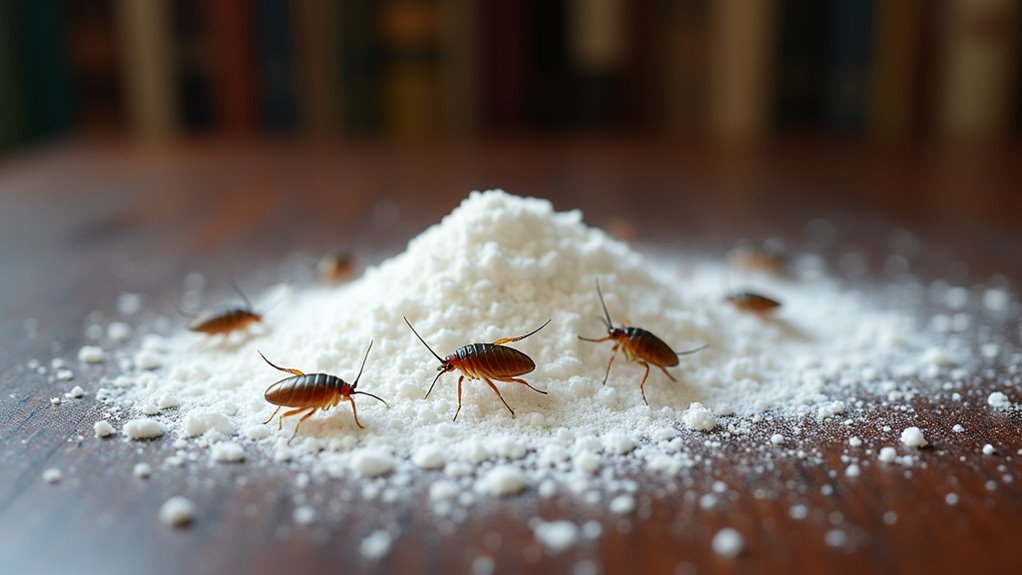Boric acid powder eliminates silverfish fast because it attacks them through a devastating dual-action mechanism. When silverfish ingest the powder, it acts as a stomach poison that disrupts their digestive systems and damages their gut lining, preventing nutrient absorption. Simultaneously, it functions as a desiccant that punctures their exoskeletons and causes rapid dehydration by increasing moisture loss. This combination of malnutrition and dehydration guarantees quick, widespread elimination of your silverfish population while allowing infected pests to spread the powder to others before dying, amplifying its effectiveness throughout their hiding spots.
What Makes Boric Acid So Effective Against Silverfish

While many pest control methods rely on repelling insects, boric acid takes a different approach by actually eliminating silverfish through multiple mechanisms.
Unlike typical repellent-based treatments, boric acid directly targets and kills silverfish using multiple deadly mechanisms of action.
When silverfish ingest this fine powder, it functions as a stomach poison that disrupts their digestive systems, causing starvation and death.
You’ll also benefit from its desiccant properties, which damage silverfish exoskeletons upon contact, leading to fatal dehydration.
The powder’s effectiveness extends to its application versatility—you can easily dust it into cracks and crevices where silverfish hide, ensuring targeted treatment of your silverfish infestation.
Since boric acid works in very small quantities, you’re getting a cost-efficient solution that delivers results without requiring large amounts of product.
How Boric Acid Disrupts Silverfish Digestive Systems
Once silverfish consume food contaminated with boric acid powder, the compound begins its destructive work on their internal systems.
You’ll find that boric acid targets the enzyme systems essential for normal food processing, disrupting digestive systems at their core. The compound damages the silverfish’s gut lining, preventing proper nutrient absorption and leading to severe malnutrition.
What makes this particularly effective is boric acid’s dual-action approach. While it’s disrupting digestive systems, it simultaneously causes dehydration in silverfish.
This combination accelerates their decline considerably. The toxic effects don’t appear immediately, taking several days to manifest. This delayed reaction is actually advantageous because infected silverfish spread the powder throughout their colony before dying, ensuring widespread elimination of the entire silverfish population.
The Dehydration Process That Kills Silverfish

Beyond disrupting digestive functions, boric acid initiates a deadly dehydration process that proves fatal to silverfish. When silverfish crawl across the powder, microscopic particles puncture their exoskeleton, creating tiny entry points that accelerate moisture loss from their bodies.
You’ll notice this effective powder adheres to silverfish during contact, remaining on their bodies as they move. During normal grooming behaviors, they inadvertently ingest the boric acid, which intensifies the dehydration process from within.
This dual-action approach—external puncturing and internal consumption—makes the treatment particularly lethal. The dehydration occurs gradually over several days, allowing affected silverfish to spread the powder throughout their colony before dying.
This slow-acting nature guarantees maximum impact across the entire silverfish population in your home.
Proper Application Methods for Maximum Results
Understanding how boric acid kills silverfish means nothing without proper application methods that guarantee maximum contact and effectiveness.
Knowing boric acid’s lethal mechanism is useless without strategic application techniques that ensure direct contact with silverfish populations.
You’ll need to apply thin layers directly into cracks, crevices, and hiding spots where silverfish congregate. Use a bulb duster or powder blower for precise placement in hard-to-reach areas without creating messy overspraying.
Regular reapplication is essential, especially in high-humidity zones where moisture reduces the powder’s potency.
Never apply boric acid near food preparation areas or water sources to prevent contamination.
You’ll maximize effectiveness by combining treatment with thorough cleaning that eliminates potential food sources like paper debris, fabric fibers, and organic matter that attract silverfish to your home.
Safety Precautions When Using Boric Acid Around Pets and Children

While boric acid effectively eliminates silverfish, you must prioritize safety when pets and children share your living space.
Store boric acid powder in secure, high locations beyond their reach to prevent accidental ingestion. Apply the product exclusively in cracks and crevices where silverfish hide, never scattering it in open areas accessible to family members. These safety precautions reduce exposure risks considerably.
Consider combining boric acid with alternative methods like diatomaceous earth to minimize the quantity needed. Always follow manufacturer instructions and use child-proof containers during application.
Keep boric acid away from pet food areas to prevent contamination. If you’re concerned about safe application, professional pest control services can handle treatment while ensuring your family’s protection throughout the silverfish elimination process.
Where to Apply Boric Acid for Optimal Silverfish Control
Once you’ve established proper safety measures, strategic placement of boric acid powder determines your success in eliminating silverfish.
Apply the powder directly into cracks and crevices along baseboards, behind appliances, and room corners where these pests hide. Focus heavily on moist areas like bathrooms and basements, as silverfish thrive in humid environments.
Dust storage spaces containing paper, fabric, or cardboard lightly, since these materials attract silverfish and harbor their eggs.
For ideal silverfish control, reapply the powder regularly after cleaning or vacuuming to maintain effectiveness.
Never apply boric acid near food sources or water to prevent contamination.
Strategic application in these key locations will effectively address your pest problems.
How Long It Takes for Boric Acid to Eliminate Silverfish
You’ll see silverfish begin dying within 1 to 2 days after they ingest boric acid powder, with noticeable population reduction typically occurring within a week.
Complete elimination of an infestation can take several weeks to a few months, depending on the severity and how thoroughly you’ve applied the treatment.
You won’t need to reapply frequently since boric acid remains effective for months in dry conditions, though you should monitor and refresh applications in high-traffic areas every few weeks.
Initial Death Timeline
When silverfish come into contact with boric acid powder, they don’t die instantly—the elimination process unfolds over several days.
The timeline for how boric acid works to eliminate silverfish follows a predictable pattern:
- First 24 hours: Silverfish show initial signs of distress as boric acid damages their exoskeleton and begins disrupting their digestive systems.
- Day 2-3: Dehydration accelerates as the powder continues breaking down their protective outer shell.
- Day 3-5: Silverfish become increasingly lethargic and weakened from moisture loss.
- Day 5-7: Complete elimination occurs after continued ingestion and contact exposure.
- Ongoing: New silverfish entering treated areas face the same systematic elimination process.
You’ll notice affected silverfish moving more slowly and appearing less active as dehydration takes effect throughout this timeline.
Complete Infestation Clearance
While individual silverfish follow this predictable elimination timeline, clearing an entire infestation requires considerably more time and patience. You’ll need several weeks to eliminate all silverfish because of their reproductive cycle and hiding patterns.
| Timeline | Expected Results |
|---|---|
| Week 1 | Initial deaths begin |
| Week 2-3 | Significant population reduction |
| Week 4-6 | Most adults eliminated |
| Week 6-8 | Complete infestation clearance |
The effectiveness of boric acid depends on consistent exposure and proper application. You must reapply the powder regularly, especially in areas with moisture that can reduce its potency. Controlling humidity accelerates the elimination process since silverfish can’t survive without adequate water sources. Focus your efforts on maintaining dry conditions while ensuring boric acid remains accessible in their hiding spots.
Reapplication Schedule Frequency
To maintain boric acid’s effectiveness against silverfish, establish a reapplication schedule of every 2-4 weeks in areas where you’ve observed frequent activity. This consistent timing guarantees continuous protection while accounting for environmental factors that reduce powder potency.
Before each reapplication, clean treated areas thoroughly since dust and debris diminish boric acid’s killing power. Monitor these zones every 1-2 weeks to track silverfish activity and adjust your schedule accordingly.
- Clean all treated areas before applying fresh boric acid powder
- Reapply every 2-4 weeks in high-traffic silverfish zones
- Monitor weekly for ongoing pest activity patterns
- Increase frequency if silverfish populations persist
- Address underlying moisture sources that reduce effectiveness
If silverfish continue appearing after multiple applications, evaluate and eliminate moisture sources in your environment, as excessive humidity compromises boric acid’s performance.
Combining Boric Acid With Other Natural Silverfish Treatments
Although boric acid works effectively on its own against silverfish, you’ll achieve even better results by combining it with other natural treatments that target these pests through different mechanisms.
Combining boric acid with complementary natural treatments creates a more comprehensive and effective silverfish elimination strategy than single-method approaches.
Diatomaceous earth pairs exceptionally well with boric acid, creating a powerful one-two punch that damages silverfish exoskeletons while poisoning their digestive systems simultaneously.
You can enhance boric acid’s attractiveness by mixing it with sugar or honey, creating irresistible bait that draws silverfish directly to the lethal powder.
Essential oils like peppermint and lavender add repellent properties to your boric acid applications, making treated areas less hospitable while maintaining killing power.
This multi-pronged approach guarantees you eliminate silverfish more efficiently than using any single treatment alone.
Signs That Boric Acid Treatment Is Working
Within the first week of applying boric acid, you’ll notice several clear indicators that your treatment is successfully eliminating silverfish from your home.
These signs confirm that your boric acid treatment is effectively controlling the infestation.
- Decreased silverfish sightings – You’ll observe fewer live silverfish in previously infested areas within days of application.
- Reduced feces presence – The amount of silverfish droppings diminishes considerably, indicating population decline.
- Dead silverfish discovery – You’ll find deceased silverfish near treated areas, confirming the treatment’s effectiveness.
- Less material damage – Damage to paper, clothing, and other consumed materials decreases noticeably.
- Cleaner environment – Overall areas appear tidier as silverfish retreat from treated zones.
These signs demonstrate that your boric acid treatment is working to eliminate the silverfish problem effectively.
Maintaining Long-Term Silverfish Prevention With Boric Acid
Since boric acid’s effectiveness diminishes over time through dust accumulation and environmental factors, establishing a consistent maintenance routine guarantees your silverfish prevention remains robust for months ahead.
You’ll need to reapply boric acid every few months in cracks, crevices, and damp areas where silverfish typically hide and breed.
For ideal long-term prevention, combine boric acid with complementary strategies like sealing food containers and controlling humidity levels.
This integrated pest management approach greatly reduces silverfish populations over time while maintaining effectiveness.
Since boric acid stays potent for several months when kept dry, you can rely on this treatment for ongoing silverfish control without frequent replacements, creating a healthier living environment.
Frequently Asked Questions
What Does Boric Acid Do to Silverfish?
You’ll find boric acid works by puncturing silverfish exoskeletons, causing dehydration. When they ingest it, you’re disrupting their digestive systems, leading to internal injuries and death from dehydration.
What Is the Fastest Way to Get Rid of Silverfish?
You’ll eliminate silverfish fastest by combining boric acid powder in cracks and crevices with immediate sanitation. Remove their food sources, reduce moisture levels, and reapply the powder regularly for maximum effectiveness.
How Long Does Boric Acid Take to Kill Insects?
You’ll see boric acid kill insects within 2 to 10 days after they’ve ingested or contacted it. The powder disrupts their digestive systems and exoskeletons, causing dehydration and eventual death.
What Is the Best Powder to Kill Silverfish?
You’ll find boric acid powder works best for killing silverfish. It’s highly effective because it disrupts their digestive system and causes dehydration when they ingest it or walk through it.
In Summary
You’ve learned that boric acid powder’s triple-action approach—digestive disruption, dehydration, and abrasive damage—makes it exceptionally effective against silverfish. When you apply it correctly in thin layers around their hiding spots, you’ll see results within days to weeks. Remember to keep it away from pets and children, and don’t rely on boric acid alone. Combine it with moisture control and other natural treatments for thorough, long-lasting silverfish elimination that’ll protect your home.





Leave a Reply